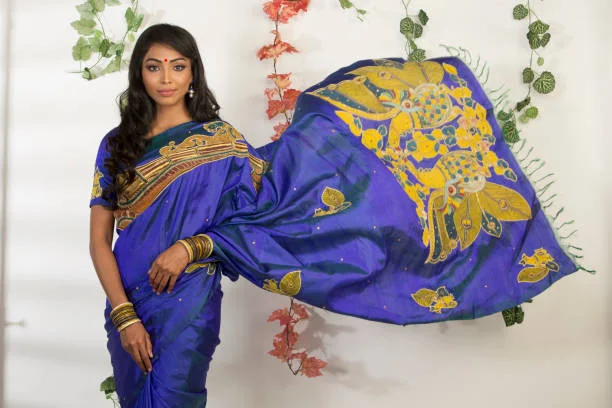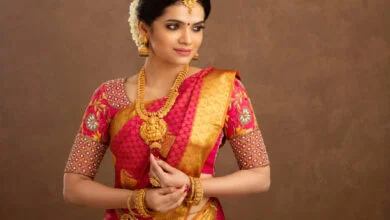The Ultimate Guide to Tussar Silk Sarees

The Ultimate Guide to Tussar Silk Sarees
Introduction to Tussar Silk Sarees
Silk, called “Kosa silk,” is a type of silk fabric which originates from the larvae of numerous silkworm species. Its rich texture and natural gold colour have made Tussar silk sarees to be known as one of the most beautiful fabrics in India. These sarees are symbols of grace as well as testimonies to the cultural richness of this nation. Tussar silk saris are an example of ethical fashion for those who support craftsmen and may also be worn by those who love sustainable attire.
History and Origin of Tussar Silk
For thousands of years, Tussar silk has been recorded in ancient texts and artifacts as being produced. Eastern India, like Jharkhand, Bihar, and West Bengal is the historical habitat of Tussar Silk. For Indian textile tradition, it has always been a major player. Cotton silk was traditionally made by the tribal communities that used to live in these areas; this group of individuals’ culture depended on it so much.
Characteristics of Tussar Silk
Tussar silk is known for its unique qualities:
- Texture: Its coarse appearance is unlike other silk material.
- Color: It can be found in shades of gold, beige, honey or cream.
- Durability: It has a higher resistance and less susceptible to creases than other fabrics.
- Breathable: This porous quality makes it more breathable and cooler for summer heat.
Varieties of Tussar Silk Sarees
Tussar silk sarees come in different types, and they look and feel different each:
1. Ghicha Tussar: This type is characterized by unfinished silk fibers.
2. Katki Tussar: It is famous for its beautiful designs and patterns.
3. Gheecha Tussar: It is hard with a natural shine.
4. Mulberry-Tussar Blend: It combines softness and texture perfectly.
Geographical Distribution of Tussar Silk Production
The major regions where tussar silk is predominantly produced include the following:
Jharkhand: Renowned for producing excellent tussar silks.
Bihar: In particular, Bhagalpur, which is known as the “Silk City.”
West Bengal: Such areas as Malda and Murshidabad.
Odisha: Known for distinct patterns and motifs.
Cultural Significance of Tussar Silk Sarees
The cultural significance of Tussar silk sarees in India is very important. They are commonly used during religious occasions, weddings and traditional events. These sarees have been handed down from one generation to another as tokens of their rich Indian heritage and family traditions.
Tussar Silk Sarees in Traditional Indian Wear
The elegance and sophistication of Tussar silk saris make them a favorite among traditional Indian clothes. Their decorative features include delicate embroidery, zari works as well as natural dyes that makes it ideal for important events.
The Process of Making Tussar Silk
Tussar silk making process is laborious and consists of various stages:
Rearing: The process involves silkworms that are raised on some particular kind of trees such as Arjun and Asan.
Harvesting: After the larvae get transformed into pupae, the cocoons are harvested.
Reeling: Silk threads are then taken out from the cocoons.
Weaving: Traditional handlooms can be used to weave threads into lovely sarees.
Different Types of Tussar Silk Weaving Techniques
The methods of weaving vary from one area to another and include:
Plain Weave: Uncluttered, beautiful, and having only one color.
Jamdani Weave: It includes some complex designs and patterns.
Bhagalpuri weave: Its characteristic is that it is strong enough plus has an individuality in patterns.
Popular Designs and Patterns in Tussar Silk Sarees
Some of the popular designs in Tussar silk sarees include:
1. Floral motifs: Nature inspired sarees with flowers and leaves.
2. Geometric patterns: Modern and contemporary styles.
3. Tribal designs: Representing indigenous people’s art and culture.
Factors Influencing the Price of Tussar Silk Sarees
Tussar silk sarees are priced based on various factors:
The quality of the silk is a determinant in its pricing because high-quality silk is expensive.
Design and craftsmanship also increase prices of tussar silk sarees.
Materials’ rarity: The scarce availability of some raw materials may lead to higher costs.
Maintenance and Care of Tussar Silk Sarees
The following are important tips for preserving the beauty and durability of Tussar silk sarees:
Dry Clean Only: Do not wash them at home to avoid any damage.
Store Properly: Place in a cool dry place, away from direct sunlight.
Handle with Care: Avoid rough use as it may destroy the integrity of the fabric.
Tussar Silk Sarees in Contemporary Fashion
Tussar silk sarees have found a place in several collections by top designers in contemporary fashion. They have been styled creatively, merging traditional aesthetics with modern sensibilities.
Celebrity Endorsements and Tussar Silk Sarees
This magnificent cloth is often worn by celebrities on red carpet events and weddings, hence making it even more popular. Their endorsements make these sarees glamorous and attractive.
Tussar Silk Sarees in Bridal Wear
Because they are luxurious and have elaborate embroidery on them, Tussar silk sarees are what many brides wear now. They look beautiful when worn by brides as they add elegance to the entire wedding ceremony.
Sustainable Practices in Tussar Silk Production
Tussar silk is relatively environmentally friendly
Silkworms are grown on natural trees in organic agriculture.
Natural Dyes: Usually used for dyeing process.
Handloom Weaving: More ecofriendly than power looms.
Challenges Faced by Tussar Silk Weavers
Despite its popularity, Tussar silk weavers face several challenges:
- Low Wages: Many weavers struggle with inadequate compensation.
- Market Competition: Facing stiff competition from machine-made fabrics.
- Lack of Recognition: Traditional artisans often lack visibility and recognition.
Government Initiatives to Promote Tussar Silk Industry
To support the Tussar silk industry, the government has taken several measures:
Financial assistance: Subsidies for producers and weavers.
Training Programmes: Skill-enhancing programmes for artists.
Marketing Assistance: The drive towards promotion of Tussar silk globally.
Global Market for Tussar Silk Sarees
An increasing desire for sustainably made clothing and Tussar silk saris has driven the global market. The USA, UK and Australia are some of the countries that export them.
Comparison of Tussar Silk with Other Varieties of Silk
When compared to other silks such as Eri, Mulberry and Muga, it can be noticed that Tussar silk is more texturized and airier. Each of the varieties has its own individual properties which make them suitable for different occasions and areas.
Tussar Silk Sarees as Artisanal Craft
The tussar silk sarees bear testimony of the artisanal skills. Every individual saree is a masterpiece, which shows how creative and skilled the weaver is.
Role of Technology in Tussar Silk Production
The Tussar silk industry is one that is becoming increasingly dependent on technology.
Developing Better Reeling Methods: Making it Faster and More Profitable.
Increase in Use of Online Marketplaces: Increased Access for Weavers to Eastern India’s Tussar Silk Fabric Market.
Online Marketing and Social Media Promotion: Helping to Sell Tussar Silk.
Tussar Silk Sarees in Regional Festivals and Celebrations
These sarees are always used during regional festivals and celebrations in India. They are even put on Bengal’s Durga Puja, Maharashtra’s Diwali, Pongal of Tamil Nadu and many more.
Cultural Adaptations of Tussar Silk Sarees in Different States
Some words, as worn on the internet, have been adapted in each Indian state with their own exclusive versions of Tussar silk sarees.
Bengal: Earned a name for itself through Baluchari and Kantha stitch.
Odisha: Known for Sambalpuri and Bomkai designs.
Chhattisgarh: Noted for vibrant colours and tribal motifs.
Tussar Silk Sarees and Empowerment of Women Weavers
By creating jobs and enabling them to be independent economically, production of Tussar silk supports women weavers. A lot of cooperatives and non-governmental organizations are in place to back up these women.
Innovations in Tussar Silk Saree Design
Examples of innovations in Tussar silk saree design are:
Fusion Styles: Mixing contemporary components with customary patterns.
Eco-Friendly Dyes: Producing brilliant colors with natural dyes.
Customized Designs: Personalizing sarees according to personal choices.
Marketing Strategies for Tussar Silk Sarees
Some effective marketing strategies for Tussar silk sarees are:
Storytelling: Focus on the history and workmanship that goes into each saree.
Collaborations: Associates with fashion designers and influencers in the market.
Sustainable Branding: emphasis on eco-friendly and ethical production methods.
Tussar Silk Sarees in the Luxury Fashion Market
Tussar silk sarees have made a name for themselves in terms of luxury fashion market. Tussar silk finds its place on designer labels’ collections therefore making it attractive to the likes of fashion savvy individuals.
Tussar Silk Sarees and Eco-Friendly Fashion Trends
Tussar silk sarees are becoming increasingly popular as eco-friendly fashion trends continue to gather pace. Because of their sustainable production method and timelessness, they have become dearly loved by the conscious consumers.
Future Prospects of the Tussar Silk Sarees Industry
With increasing knowledge and respect for sustainable fashion, the future of Tussar silk saree industry seems bright. The artistry is supported continuously with advancement in technology and creative designs; all these will motivate growth.
To sum it up, Tussar silk sarees epitomize a perfect fusion of heritage, skillfulness and eco-friendliness. By going for Tussar Silk you are not only accepting a cultural richness but also supporting ethicality in fashion. Unveil the universe encompassing Tussar silk sarees; an everlasting gift that uplifts your wardrobe while having positive influence on people’s lives.
To learn more about Tussar silk and other related issues keep watching our blog or follow us via social media.






